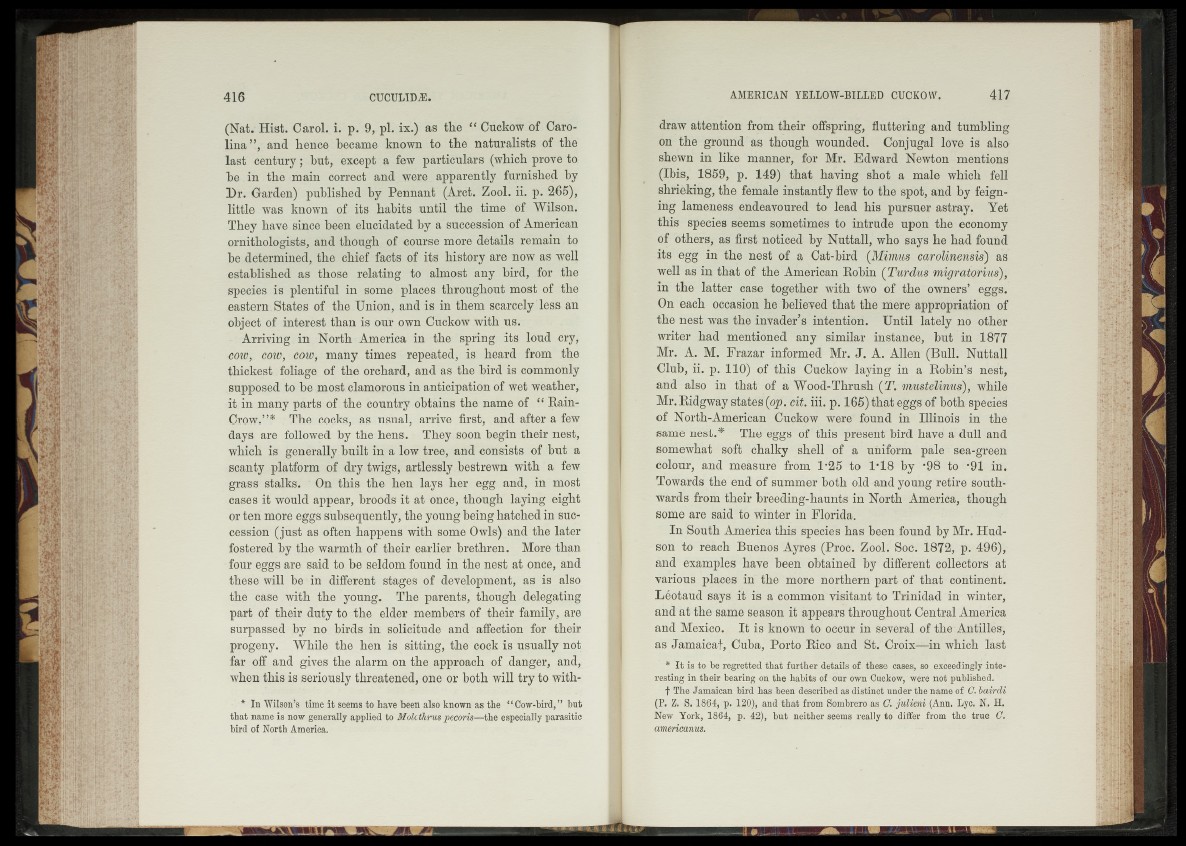
(Nat. Hist. Carol, i. p. 9, pi. ix.) as the “ Cuckow of Carolina
”, and hence became known to the naturalists of the
last century; hut, except a few particulars (which prove to
be in the main correct and were apparently furnished by
Dr. Garden) published by Pennant (Arct. Zool. ii. p. 265),
little was known of its habits until the time of Wilson.
They have since been elucidated by a succession of American
ornithologists, and though of course more details remain to
he determined, the chief facts of its history are now as well
established as those relating to almost any bird, for the
species is plentiful in some places throughout most of the
eastern States of the Union, and is in them scarcely less an
object of interest than is our own Cuckow with us.
Arriving in North America in the spring its loud cry,
cow, cow, cow, many times repeated, is heard from the
thickest foliage of the orchard, and as the bird is commonly
supposed to be most clamorous in anticipation of wet weather,
it in many parts of the country obtains the name of “ Rain-
Crow.” * The cocks,; as usual, arrive first, and after a few
days are followed by the hens. They soon begin their nest,
which is generally built in a low tree, and consists of hut a
scanty platform of dry twigs, artlessly bestrewn with a few
grass stalks. On this the hen lays her egg and, in most
cases it would appear, broods it at once, though laying eight
or ten more eggs subsequently, the young being hatched in succession
(just as often happens with some Owls) and the later
fostered by the warmth of their earlier brethren. More than
four eggs are said to he seldom found in the nest at once, and
these will he in different stages of development, as is also
the case with the young. The parents, though delegating
part of their duty to the elder members of their family, are
surpassed by no birds in solicitude and affection for their
progeny. While the hen is sitting, the cock is usually not
far off and gives the alarm on the approach of danger, and,
when this is seriously threatened, one or both will try to with*
In Wilson’s time it seems to Lave been also known as the “ Cow-bird,” but
that name is now generally applied to Molcihrus pecoris—the especially parasitic
bird of North America.
draw attention from their offspring, fluttering and tumbling
on the ground as though wounded. Conjugal love is also
shewn in like manner, for Mr. Edward Newton mentions
(Ibis, 1859, p. 149) that having shot a male which fell
shrieking, the female instantly flew to the spot, and by feigning
lameness endeavoured to lead his pursuer astray. Yet
this species seems sometimes to intrude upon the economy
of others, as first noticed by Nuttall, who says he had found
its egg in the nest of a Cat-bird •(Mimus carolinensis) as
well as in that of the American Robin (Turdus migratorius),
in the latter case together with two of the owners’ eggs.
On each occasion he believed that the mere appropriation of
the nest was the invader’s intention. Until lately no other
writer had mentioned any similar instance, but in 18 7 7
Mr. A. M. Frazar informed Mr. J. A. Allen (Bull. Nuttall
Club, ii. p. 110) of this Cuckow laying in a Robin’s nest,
and also in that of a Wood-Thrush ( I 7, mustelinus), while
Mr. Ridgway states (op. cit. iii. p. 165) that eggs of both species
of North-American Cuckow were found in Illinois in the
same nest.* The eggs of this present bird have a dull and
somewhat soft chalky shell of a uniform pale sea-green
colour, and measure from 1*25 to 1*18 by *98 to *91 in.
Towards the end of summer both old and young retire southwards
from their breeding-haunts in North America, though
some are said to winter in Florida.
In South America this species has been found by Mr. Hudson
to reach Buenos Ayres (Proc. Zool. Soc. 1872, p. 496),
and examples have been obtained by different collectors at
various places in the more northern part of that continent.
Leotaud says it is a common visitant to Trinidad in winter,
and at the same season it appears throughout Central America
and Mexico. It is known to occur in several of the Antilles,
as Jamaicaf, Cuba, Porto Rico and St. Croix—in which last
* I t is to be regretted that further details of these cases, so exceedingly interesting
in their bearing on the habits of our own Cuckow, were not published.
f The Jamaican bird has been described as distinct under the name of C. bairdi
(P. Z. S. 1864, p. 120), and that from Sombrero as G. julieni (Ann. Lyc. N. H.
New York, 1864, p. 42), but neither seems really to differ from the true C.
americanus.